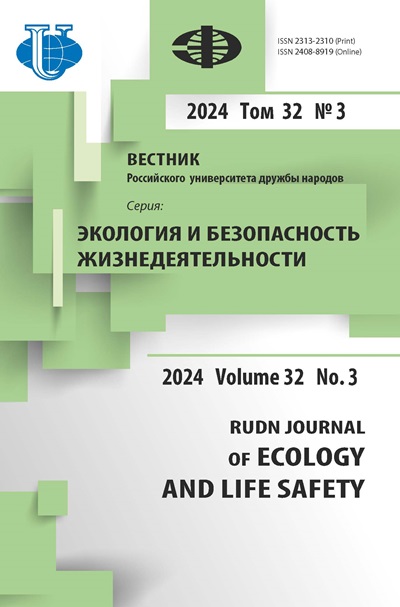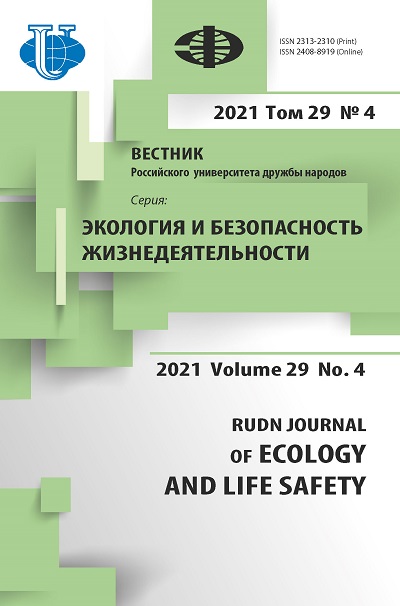Vol 29, No 4 (2021)
- Year: 2021
- Articles: 7
- URL: https://journals.rudn.ru/ecology/issue/view/1539
- DOI: https://doi.org/10.22363/2313-2310-2021-29-4
Full Issue
Ecology
Study of interaction of xenobiotics with macrophytes in experimental aquatic ecosystems
Abstract
Phytotoxicity of three types of organic xenobiotics (ethyl acetate, butanol-1, tetrachloromethane) was evaluated when three macrophyte species Ceratophyllum demersum , Elodea canadensis , Chara fragilis were exposed. Pollutant concentrations of 5 and 10 MAC (maximum allowable concentration) were created in microcosms. Incubation lasted for 14 days. New information was obtained experimentally that C. fragilis macrophyte is a highly sensitive test object, which can be used for bioindication purposes. Xenobiotics had no toxic effects on E. canadensis , so it can be considered for phytoremediation purposes. The data obtained are necessary for the development of phytotechnologies for water purification. A number of conditions under which these plant species can be used for ecotechnology are shown.
 305-314
305-314


Studying the vegetation impact of terrestrial ecosystems on reducing the carbon footprint in in the territory of the Russian Federation
Abstract
Plant communities of terrestrial ecosystems of the Russian Federation are studied in terms of their ability to reduce the carbon footprint as a result of carbon dioxide sequestration. The classification of typical plant communities and the division of the territory depending on the climatic and regional characteristics is given, with further provision of values of the specific absorption capacity of growing plant communities according to the division presented. To assess the biomass of vegetation, as well as its dynamics of change, an analysis of the remote sensing method was carried out as the most preferred method for determining biomass in real time. The characteristics of currently used remote sensing systems, including IKONOS, Quickbird, Worldview, ZY-3, SPOT, Sentinel, Landsat and MODIS are given. The main indicators used for the indexation assessment of vegetation biomass are listed, with subsequent prediction based on them of the efficiency of carbon dioxide uptake by plant communities.
 315-327
315-327


Environmental Monitoring
Landscape analysis of problems of indicating sustainable development goals for the least developed countries on the example of Afghanistan
Abstract
Sustainable development of Afghanistan is prevented by many factors, both purely anthropogenic genesis, and natural. In this study, author tries to make an initial assessment of the possibility of indicating geoecological problems in Afghanistan by indicators of the sustainable development goals based on landscape analysis. This will allow to identify priorities in the practical application of these indicators, and to conduct field assessments with maximum efficiency. Author makes a point assessment of the priorities of the indication of the geoecological problems of different landscape units of Afghanistan, and the related assessment of tension of the geoecological situation.
 328-340
328-340


Environmental Economics
Evaluation and use of existing economic valuation methodologies in the management of Lake Victoria’s water resources
Abstract
Lake Victoria is the second-largest freshwater lake in the world, with an eco-system critical to 25-30 million inhabitants of Kenya, Uganda, Tanzania, Rwanda, and Burundi who live in the lake basin. The lake provides several ecosystem services from inland waterway transport, fisheries to hydropower and supports many different industries such as tourism, trade, and wildlife. However, Lake Victoria’s ecosystem management has been highly extractive; hence its water resources are either inefficiently or overused. This is because the value of this resource is either unknown or underestimated. The main purpose of the research was to contribute to Lake Victoria’s conservation efforts by providing the best techniques that can be used to assess the value of this resource and develop appropriate policies for the sustainable management of the lake. The study reviewed relevant literature on the economic assessment methods of environmental resources in the context of water management. Search engines such as Google Scholar, Web of Science, and ScienceDirect were used for it. The study suggests methods for economic valuation of Lake Victoria water ecosystem for each service. The proposed techniques can be used for assessing the value and benefits of conservation and restoration of Lake Victoria ecosystem.
 341-354
341-354


Industrial Ecology
Resource potential of the mountain part of Siberian Federal District as factor of sustainable development of the region
Abstract
The article assesses the resource and socio-economic potential of the mountainous part of the Siberian Federal District - one of the largest federal districts of Russia with unique natural resources, difficult natural living conditions and sufficiently developed economic conditions. The methodology developed by the scientists of the Dubna University was adopted as a method for the calculations. This technique differs in that, on a single methodological basis, using physically measurable quantities and expressed in one unit of measurement, to assess the resource potential of the region. This approach is universal for all regions of the world. The scenarios for the development of the subjects of the Siberian Federal District in the economic, social and environmental spheres have been established. The classification of regions is carried out in relation to the extensive and innovative development of the economy and society. For the transition of the subjects of the Siberian Federal District to the rails of sustainable innovative development, it is necessary to increase the efficiency of production in accordance with the demographic, social and environmental policy, as well as to reduce the consumption of natural energy resources.
 355-370
355-370


The effectiveness of the scrubber method of cleaning exhaust gases in industry
Abstract
Unfortunately, not all types of industry have a positive impact on the environment and people, for example, the processes of the chemical and textile industries can be accompanied by the release of toxic and harmful gases, dust and steam. And already, along with the exhaust gases, they are released into the atmosphere, while the negative impact on the overall environmental situation only doubles. That is why the importance of cleaning the emitted gases in the process of industrial activity cannot be underestimated. The most popular and most effective method of cleaning from dust emissions can be designated as the scrubber method of air purification, precisely at the moment when the air being eliminated has a relatively high temperature level. In addition, the use of the heat of condensation of water vapors contained in them is a particularly effective direction for increasing the depth of heat recovery of wet gas and steam generator gases leaving heat technology devices. This article is devoted to the study of the stages and models of the process of designing and constructing a device for wet cleaning of gases that are released into the atmosphere as a result of certain production activities. The study of the systems of utilization of secondary energy resources used at the present time was also carried out.
 371-380
371-380


Environmental education
Environmental baseline assessment - changes 2022
Abstract
The article examines the changes in the requirements of the legislation of the Russian Federation on the assessment of the current state of the environment carried out within the framework of engineering and environmental surveys and the requirements for the preparation of project documentation in terms of environmental impact assessment. Taking into account the updated requirements of legislation is important, not only in the preparation of project documentation - environmental impact assessment and a list of environmental protection measures, but also in the training of environmental specialists. It is essential that the graduate students are aware of the requirements of the legislation and understands that the legislation is subject of change.
 381-385
381-385
















